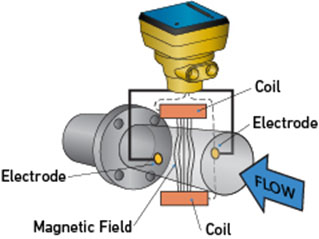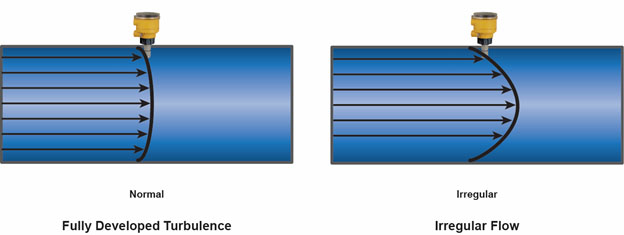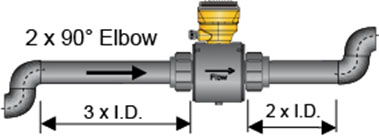Plastic Flow Meters Reduce Weight, Space, Corrosion — Not Accuracy
There are a variety of reasons for wanting accurate flow metering — e.g., billing purposes, precise proportioning of chemical injections, and other process flow decisions. That is why highly accurate mag meters are so popular in many applications. Now, new lightweight, corrosion-resistant mag meters provide the same advantages as plastic piping for harsh environments and flows that cover all the bases…and acids.
The Straight Advantages Of Full-Bore Plastic Mag Meters
Every pipeline flow-measurement technology has its advantages and disadvantages — purchase cost, basic accuracy, repeatability, turndown ratio, straight-run requirements, tolerance to various conditions within the pipeline, etc. New chemical-resistant PVC mag meters expand the advantages of full-bore mag meters to more applications without the disadvantages of other flow measurement options.
- Complete Coverage. A core advantage of mag meters is that they read the entire cross-section of the liquid flow (Figure 1), not just one spot within a limited segment of flow as an insertion mag meter does (Figure 2A). This gives them the capability to produce accurate readings even in the presence of varying turbulence within the pipe. Also, because the sensors are part of the meter body cylinder, they create no resistance or pressure drop in the flow of liquid through the body of the meter.

(Graphic courtesy of GF Piping Systems)
Figure 1. A full-bore mag meter uses Faraday’s Law to measure flow velocity as the strength of an electric signal generated by the disruption of a magnetic field spanning the full width of the pipe. This allows for accurate representation of the total flow volume to + 1.0 percent.

(Graphics courtesy of GF Piping Systems)
Figures 2A and 2B. Flow Velocity Profiles. Even in straight, smooth piping, liquids do not flow at identical speeds across the full diameter of the pipe. Flows are faster in the center of the pipe and slower near the interior wall of the pipe. Insertion-type meters are designed to take their reading at about 10 to 12 percent of the depth into the pipeline diameter, where the average flow rate between the fastest and slowest flow segments in a well-developed flow profile (left) normally occurs. Any irregularity that disrupts the shape of that flow profile (right) — such as rough interior pipe walls — can distort the accuracy of the projected insertion mag meter reading for the full cross-section of the pipe.
- Tolerance To Turbulence. Each flow sensing technology has different reactions to disruptions in the flow velocity profile in a pipeline. Because both insertion-type and full-bore mag meters operate on a very consistent electronic principle (Faraday’s Law), they have the potential to achieve high accuracy. Each type, however, reacts differently to two types of potential turbulence in a pipeline:
- Fully Developed Turbulent Profile. Insertion-type mag meters can achieve relatively good accuracy if the piping flow exhibits a fully developed turbulent flow profile, where the fastest flow occurs through the middle of the pipe and a slower flow occurs only near the interior wall. Insertion-type flow meters are typically positioned at a point 10 percent to 12 percent of the way into the interior pipe diameter where the average fluid velocity occurs (Figures 2A and 2B). They project the flow measured there to the full cross-section of pipe. In that arrangement, anything that disrupts a fully developed flow profile can lead to inaccuracies in the final reading.
- Disruptive Turbulence. Another type of turbulence — irregular and inconsistent turbulence introduced into the pipeline by elbows, tees, valves, reducers, etc. (Figure 3) — can skew flow velocity at an insertion mag meter’s single point of measurement, making its reading less accurate. Full-bore mag meters average out those differing velocities across the full diameter of the pipe, so they are less susceptible to such disruptive turbulence.
- ‘Straight Pipe’ Diameters. Whatever the source or form of turbulence involved, one requirement dictated by different flow meter technologies is how much straight pipe length — defined as multiples of the pipe diameter (d) — is required upstream or downstream of the meter. This is the distance needed to allow a fully developed velocity profile to form downstream from the point where turbulence is introduced. For example, those requirements might be 15d after a 4” x 2” reducer, 20d after a 90-degree elbow, 40d after a butterfly valve or gate valve, and up to 50d after a pump discharge. Because full-bore mag meters average out those differing velocities across the full flow profile in the pipe, they are less susceptible to specific areas of disruptive turbulence (Figure 3).

(Graphic courtesy of GF Piping Systems)
Figure 3. Disruptive Turbulence. Unlike insertion-type mag meters where reading accuracy can be disrupted by inconsistent turbulence generated from a variety of pipeline structures, full-bore mag meters can tolerate being mounted closer to such sources of turbulence. They can be installed as close as 3 pipeline diameters downstream and 2 pipeline diameters upstream from multiple sources of flow disruption. Other types of meters can require from 15 to 50 diameters of straight pipe after certain structures to assure their rated accuracy.
- Flow Sensitivity/Turndown. A full-bore mag meter offers a wider dynamic range of application for flow and a much larger turndown ratio than paddlewheels or virtually any other flow-sensing device. A full-bore mag meter provides accuracy at flow speeds down to 0.07 feet per second (fps) and up to 33 fps or more (a >450:1 turndown ratio) as opposed to a paddlewheel meter that requires a minimum flow of 0.3 fps and maxes out at about 20 fps (only a 66:1 turndown ratio).
Better Mag Meter Choices For Multiple Reasons
Within the range of accurate mag meter options, plastic body mag meters stand out from all others in terms of both chemical resistance and installed weight of the units. Here are some of the advantages to consider:
- Accurate Readings. Every measurement technology can generate reliable, repeatable accuracy within the limits of their specified performance conditions and within a relative range of costs. PVC full-bore mag meters can deliver out-of-the-box accuracy to + 1.0 percent of the reading, plus corrosion resistance, at an affordable purchase cost and with minimal mounting requirements.
- Weight Savings. While metal-body full-bore mag meters are currently used in plastic piping systems, the lighter weight of new PVC-body mag meters also offers physical and practical alternatives for conventional piping installations and compact skid-mounted systems:
- Lower Cost. Without a heavy cast or machined metal body, a PVC full-bore mag meter offers a more affordable solution than metal-body mag meters. This helps to keep down the OEM unit costs of skid-mounted systems without compromising reading accuracy.
- Space-Saving Accuracy. Piping systems with severe space restrictions — such as water distribution pumping stations or skid-mounted wastewater treatment units — often do not have the luxury of long, straight piping runs to eliminate the turbulence generated by elbows, valves, or other fittings. A PVC full-bore mag meter can deliver peak flow measurement accuracy in tightly configured installations — without the weight and expense of a metal-body full-bore mag meter.
- Easier Installation. Wherever mag meters need to be mounted in overhead, awkward, or out-of-the-way places, the lighter weight of a PVC-body mag meter simplifies the physical installation process.
- Less Stress On Piping Infrastructure. Because a PVC mag meter weighs less than a comparably sized metal-body mag meter, it exerts less stress on suspended piping installations, reducing the complexity of support structures required.
- Chemical Resistance. A PVC mag meter body offers the same corrosion and chemical resistance as the PVC piping system in which it is installed. This includes the ability to handle chemically treated water, wastewater, and industrial chemicals. Chemical-resistant stainless steel or titanium electrodes offer corrosion resistance for chemical delivery applications commonly found in water treatment applications.
- Versatile Output Convenience. Visual LED indicators make sensor stats easy to read, even in overhead mounting locations. Adding bluetooth capabilities makes it easy to tie precise readings into a process control or SCADA system. It also enables linking to smartphones empowered by analytics software to view analog flow rates, change the scale of the output, and access other diagnostic information.
New Opportunities To Remedy Old Problems
While a new PVC-body mag meter is an ideal match for new plastic piping systems, it also offers a cost-effective opportunity to upgrade underperforming paddle-type meters or insertion-type mag meters in installations with insufficient straight-run piping. This offers a significant boost in accuracy for skid-mounted systems that must deal with tight piping layouts with tight turns in severely constrained spaces.
The easy ability to cement PVC flange or union-type fittings onto existing PVC piping enables convenient retrofit solutions. PVC mag meters also offer convenient replacement for heavy metallic full-bore mag meters, particularly when the lay length of the PVC meter is longer than the lay length of the meter it replaces so that only one side of the piping needs to be cut and re-flanged. Here are several examples of how the physical performance characteristics of PVC mag meters offer competitive advantages for new or retrofit applications:
- Skid-Mounted Solutions. In OEM packaged solutions, such as mobile water treatment systems, both weight restrictions and limited space for straight-run piping demand more aggressive solutions. Full-bore mag meters made of durable PVC materials and weighing less than 8 pounds can still deliver + 1.0 percent accuracy even when mounted within 3d of an elbow, tee, or valve.
- Plastic Piping Systems. Plastic piping applications that demanded the accuracy of full-bore mag meters formerly required extra structural components to support the added weight of a metal mag meter. Now, they can obtain the same performance accuracy, plus corrosion resistance, from a PVC mag meter that weighs less than 8 lbs.
- Corrosive Environments. While not all water or wastewater treatment applications are highly corrosive, many are. Now, even clean water treated with disinfectants such as sodium hypochlorite can have premium full-bore mag meter performance with the longevity of all-PVC materials.
PVC mag meters also offer economical alternatives in metallic piping systems, if the connected pipes are properly aligned and supported so as not to put stress on the PVC mag meter body. (Consult manufacturer for use in metal piping applications.) The common practice of using bolt-up flanges to help draw misaligned pipe into position should be avoided to prevent damage to the PVC mag meter body.
Better Options For Multiple User Concerns
There are as many applications for PVC mag meters as there are concerns by a variety of decision-makers:
- Plant Operators looking for highly accurate and consistent flow measurements can retrofit existing installations or plan new ones with fewer concerns about costs, performance accuracy, spacing, or weight.
- OEM System Builders can reduce not only the weight of existing designs but also component costs, while providing top-of-the-line measurement accuracy in space-constrained layouts. A one-time design revision will enable them to reap the long-term benefits of elevating customer satisfaction with the improved cost-effective performance of their prepackaged designs.
- Specifying Engineers can explore new options to refine design footprints and earn the gratitude of clients who appreciate the performance advantages of more economical, more accurate, more chemical-resistant, and lighter-weight flow-metering solutions.
- System Integrators can gain the freedom to cut purchase and installation costs of replacing metal-body full-bore mag meters in installations where weight and/or corrosion resistance are concerns.
